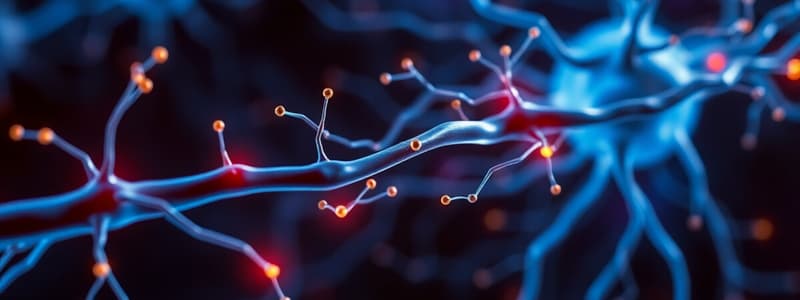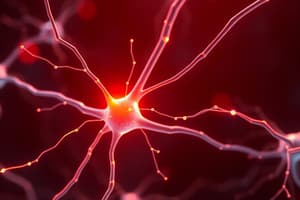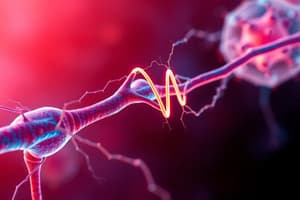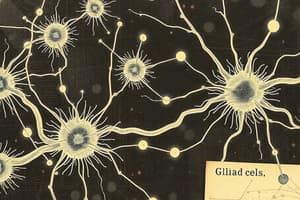Podcast
Questions and Answers
What is the function of afferent nerve impulses?
What is the function of afferent nerve impulses?
- To block pain transmission
- To synthesize neurotransmitters
- To transmit impulses from the brain to the body
- To carry sensory information to the brain (correct)
What role do synaptic vesicles play in neurotransmission?
What role do synaptic vesicles play in neurotransmission?
- They store and release neurotransmitters. (correct)
- They protect the nerve fibers from damage.
- They synthesize neurotransmitters directly.
- They facilitate the conduction of impulses along the axons.
What does synaptic transmission involve?
What does synaptic transmission involve?
- Direct junctions between nerves.
- The continuous flow of impulses through membranes.
- The conversion of neurotransmitters into enzymes.
- The jumping of impulses across synapses. (correct)
Which event occurs immediately after neurotransmitters are released into the synaptic cleft?
Which event occurs immediately after neurotransmitters are released into the synaptic cleft?
How do local anaesthetics block nerve transmission?
How do local anaesthetics block nerve transmission?
What condition results from excessive nerve impulses?
What condition results from excessive nerve impulses?
What happens when the herpes simplex virus reactivates?
What happens when the herpes simplex virus reactivates?
How are neurotransmitters inactivated after their action?
How are neurotransmitters inactivated after their action?
Flashcards are hidden until you start studying
Study Notes
Nerve Impulses
- Nerve impulses are initiated by stimulation of sensory nerve endings or by the passage of an impulse from another nerve.
- Afferent (sensory) impulses travel TO the brain and CNS.
- Efferent (motor) impulses travel FROM the brain and CNS.
- Nerve impulses travel down the neurone.
Synaptic Transmission
- Synapse: the point at which a nerve impulse jumps from one nerve to another.
- There are approximately 1000 trillion synapses in the brain.
- Synaptic knobs contain synaptic vesicles which store neurotransmitters.
- Neurotransmitters are released into the synaptic cleft.
Neurotransmitter Journey
- Synthesized by nerve cell bodies.
- Actively transported along the axons.
- Stored in synaptic vesicles.
- Released by exocytosis in response to the action potential.
- Diffuse across the synaptic cleft.
- Act on specific receptor sites on the post synaptic membrane.
- Action is short-lived.
- Inactivated by enzymes or taken back into the synaptic knob after action.
Local Anaesthetics
- Block nerve transmission to pain centers by inhibiting sodium channels in the cell membrane of nerve cells.
- This action obstructs the movement of nerve impulses near the site of injection, but awareness and sense perception in other areas are not affected.
Neuralgia
- Excessive nerve impulses can result in neuralgia.
- Trigeminal neuralgia is the most common type.
- Herpes simplex virus lies dormant in the trigeminal ganglion.
- When reactivated, the herpes simplex virus travels down the trigeminal nerve emerging on the lip and causing a cold sore.
Studying That Suits You
Use AI to generate personalized quizzes and flashcards to suit your learning preferences.




